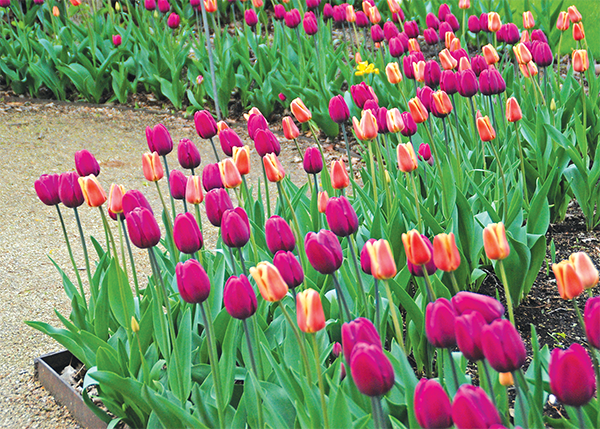 By Melinda Myers
By Melinda Myers
Bright yellow daffodils, colorful tulips and fragrant hyacinths brighten our spring gardens. Give them the care they need to extend their spring display and keep them coming back for years.
Hybrid tulips and hyacinths are short-lived stars of the spring garden. They bloom profusely the first spring, but the number of flowers decline each year. You may want to treat these like annuals, carefully removing them from the garden to avoid damaging any remaining plants. Toss these in the compost pile and start planning for their replacements. It is a great opportunity to try something new and freshen the look of your spring garden. If you are looking for a permanent replacement, consider using species tulips that are less floriferous but return each year.
Add a few years to the life of hybrid tulips and daffodils and get the most from all your long-lived spring flowering bulbs with proper care. Water spring gardens thoroughly whenever the top few inches of soil are crumbly and just slightly moist. Spring rains often take care of this task, but when they do not it is easy to forget to provide spring gardens with the water they need. Providing the right amount of water when needed will keep your bulbs looking their best.
Bulbs often receive sufficient nutrients at the time of planting or when the other plants in the garden are fertilized. Apply fertilizer to established bulb plantings, if needed, as the leaves begin to emerge from the soil. Use a low nitrogen, slow-release fertilizer to encourage slow steady growth. Follow the label directions so you apply the recommended amount for the area you are fertilizing.
Remove spent flowers on tulips and hyacinths you plan to keep so the energy is directed back into the bulbs instead of setting seeds. Do the same if you want to improve the appearance of daffodils. Leave allium seed heads in place to extend their beautiful contribution to the garden. Remove these before they drop their seeds if you want to limit the number of seedlings sprouting in next year’s garden. The same is true for grape hyacinths and squills. The only reason to remove their faded flowers is to slow down the spread.
Leave the leaves on your bulbs until they naturally yellow and dry. The leaves produce energy needed for beautiful blooms next spring. The longer you leave the leaves intact, the more energy and better bloom for next season.
Hide the declining bulb leaves by planting annuals between the bulbs. Or add perennial flowers that return each year for a more permanent solution. As the bulbs decline, the perennials will grow and mask the declining foliage. Try mixing spring flowering perennials for double the impact or combine with summer and fall bloomers to extend the floral show.
Take some pictures of your spring bulb display and make notes of the areas where you want to add some color. Then order early for the best selection and to make sure you are ready for bulb planting season next fall.
Melinda Myers has written more than 20 gardening books, including Small Space Gardening. She hosts The Great Courses “How to Grow Anything” DVD series and the nationally-syndicated Melinda’s Garden Moment TV & radio program. Myers is also a columnist and contributing editor for Birds & Blooms magazine. Her website is www.MelindaMyers.com.
Providing proper care to tulips and other spring flowering bulbs will extend your enjoyment and keep them coming back for years. Photo credit: MelindaMyers.com





